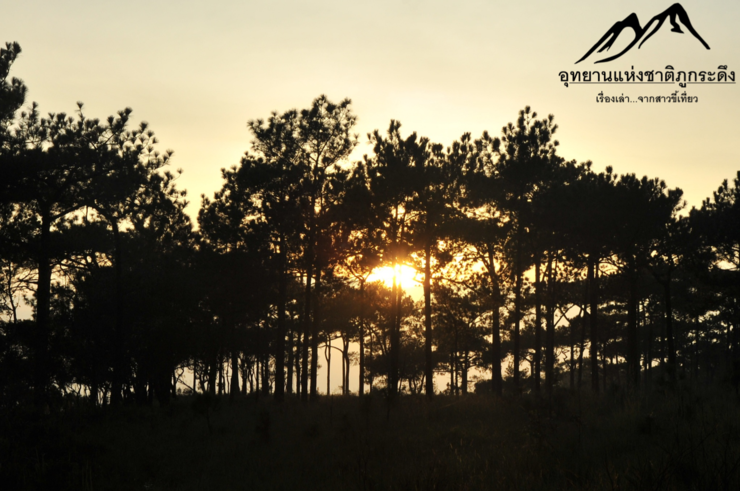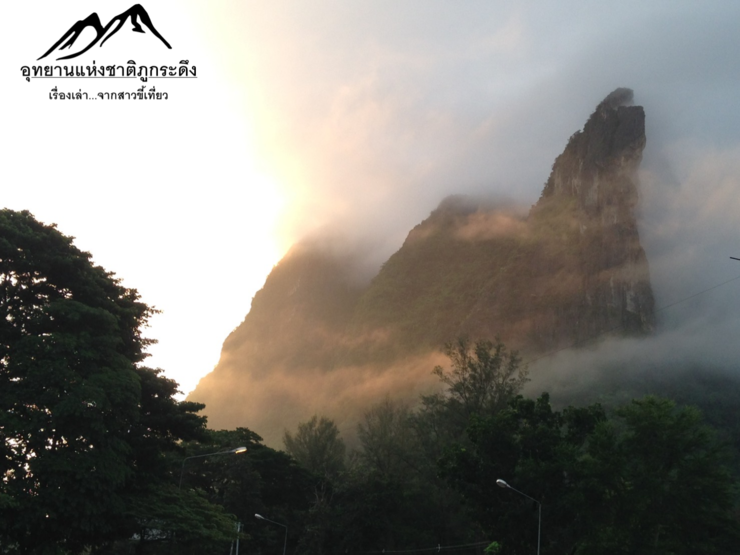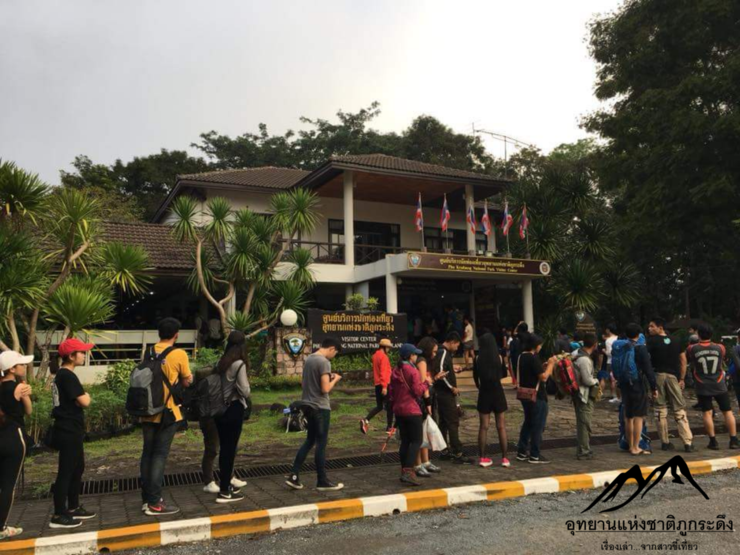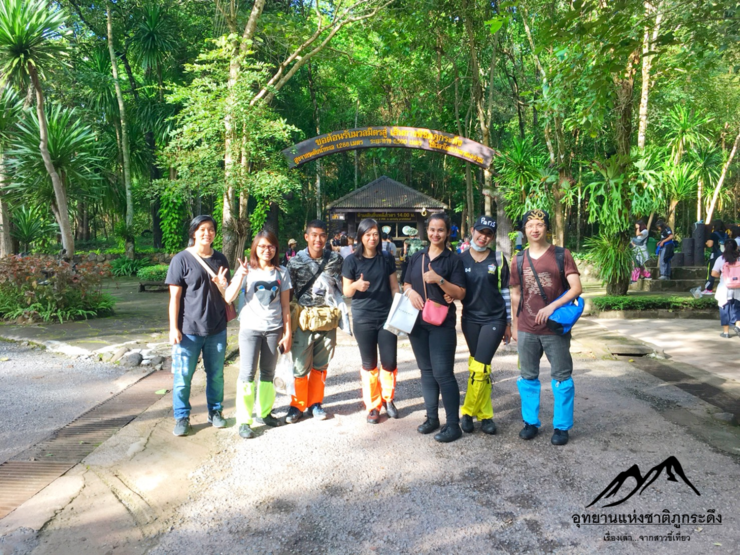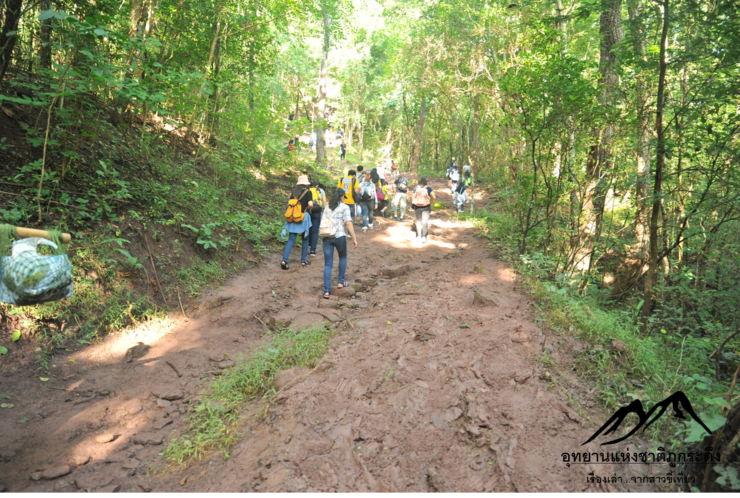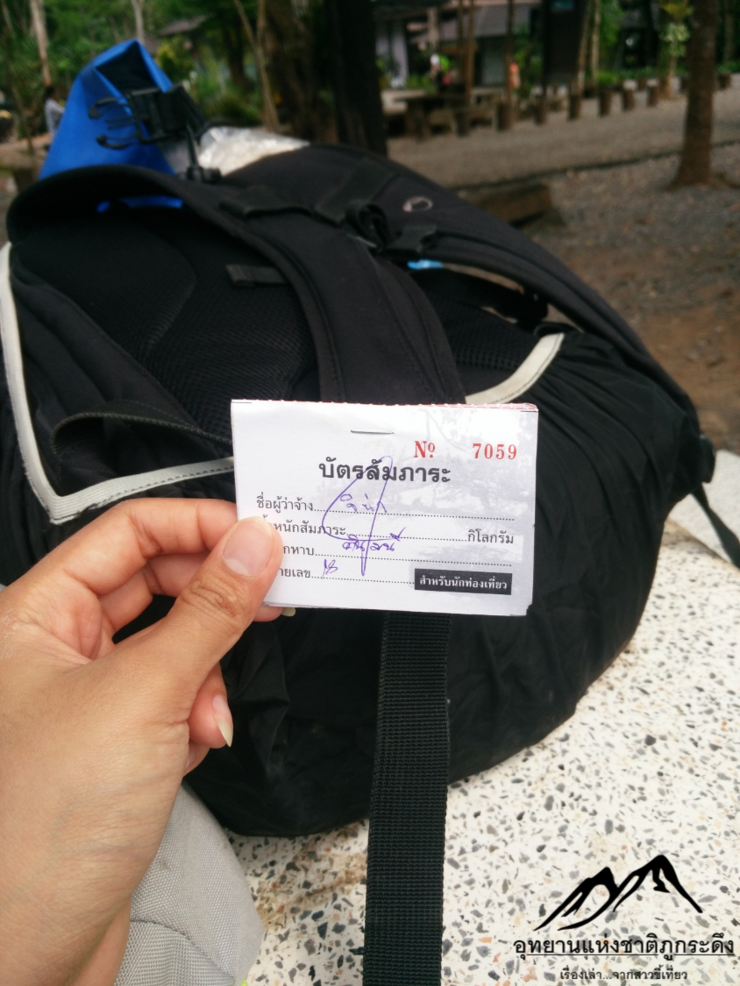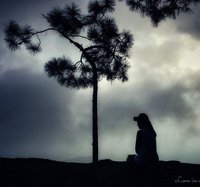Phu Kradueng National Park, Phu Kradueng District, Loei Province
The park covers an area of approximately 348.12 square kilometers, or 217,576.25 rai. It was established as a national park on October 7, 1959, making it the second national park in Thailand after Khao Yai National Park. The park's terrain is characterized by sandstone mountains with flat summits, located in the northwest of the Khorat Plateau near the eastern slopes of the Phetchabun Mountains. Most of the mountains in the park range in elevation from 400 to 1,200 meters above sea level, with the highest peak being Phu Kum Khao at approximately 1,350 meters. The flat area on the summit of Phu Kradueng covers an area of 60 square kilometers, or about 37,500 rai, resembling the shape of a taro leaf. This area supports a community of temperate plants, including two-leaved pine forests, three-leaved pine forests, maple forests, and beautiful flowering plants. The park enjoys a cool climate year-round, with freezing temperatures in the winter.

Phu Kradueng, a place of natural beauty and adventure.
Let's go to Phu Kradueng... We departed from Bangkok to Phu Kradueng on October 12, 2017. We got a bus ticket from Phu Kradueng Tour, 9:30 PM round. We informed the staff on the bus that we would get off at Pha Nok Aew. The bus will stop for everyone. As soon as we got on the bus, we fell asleep immediately (we were exhausted from working all day, so we decided to take a nap first).

Day 1
Approximately 6:30 AM on October 13, 2017, the bus arrived at Pha Nok Aew. Don't worry about being alone, as many people get off at this stop.
We got off the bus and crossed the street to the other side where Auntie Kim's shop is located. Auntie Kim's shop offers rice with curry, freshly brewed coffee, and free bathroom services. You can also book bus tickets back to Bangkok here (we booked here because we couldn't book from Bangkok in time, all companies were full).
You can have breakfast, take a shower, change clothes, or take a nap to recharge. There are beds with mats behind the shop where you can lie down and rest for free. However, all we did was wash our faces, brush our teeth, and head straight to the queue for the shared taxi because we wanted to arrive at the park early to avoid the crowds (or so we thought). The price for the shared taxi is 300 baht per car (if you rent the whole car) and the car leaves immediately. However, if you are traveling alone or in a small group, you have to wait until the car is full. With 10 people, the car leaves. The fare is 30 baht per person. It takes less than 30 minutes to reach the park's headquarters.

Upon arrival, you can purchase tickets, pay fees, and reserve tents directly at the location. (We visited during a long holiday weekend, so it was a bit crowded.)

After booking your tent, take the luggage and belongings you want the porter to carry to be weighed and receive a luggage tag. The service charge is 30 baht/kilogram. (Keep the tag stub safe, as you will need it to collect your luggage at the tourist service point.) It is recommended to bring only essential items to avoid burden and save on porter fees.

Okay, it's time to go. 1, 2, 3, heave-ho, heave-ho… We started walking at 8:00 AM.




The 5.5 km trail from the foot of the mountain to the back of Pae features 10 rest stops, known as "sam."

And then we arrived at the first rest stop called "Sam Haek". There are shops here. If you are tired or thirsty, you can stop to drink water, eat something, or just sit and rest. The auntie doesn't charge you, but the prices of goods here are expensive according to the height and distance.

After a well-deserved rest, the journey continues, for the road ahead is long.



The trail from Sam Haek is relatively flat, with occasional rolling hills that are not too steep. It is a comfortable walk.

We take breaks at every rest stop, continuing our journey at a leisurely pace. Wherever we find a place to rest, we take a break, walking at a relaxed pace.


Along the way, we encountered porters walking down. The most frequently asked question was, "How much further is it?"

Almost there...!! Almost there, keep fighting! ( Response from the porter )

The last 2 kilometers of the walk were a gradual uphill climb, or perhaps it was just my imagination.

After passing through numerous "sam"s (a type of natural pool in a stream), we finally reached the last one before the steep ascent to the "lang pa" (a flat area on top of a mountain). The climb was incredibly challenging.

After a 5.5 km climb, we reached the back of the waterfall. It took us 5 hours to get there (but don't get too excited, we're not there yet). We took a break to take photos and rest our legs before continuing on the 3.5 km hike to the Wankwang base camp (the tourist service point or camping area).


After resting for a while, we continued walking. All I could think about was whether I could teleport to the campsite. It seemed like we were getting closer, but we weren't quite there yet.



We covered a distance of 3.5 kilometers on flat terrain, taking two hours with breaks due to the heat. We finally reached our destination.

Proceed to the Tourist Service Center to collect your tent, pillow, sleeping bag, and sleeping mat. Please wait for your luggage to be delivered by the porters.
Here is the translation of the text you provided:
The first paragraph describes the feeling of hunger after setting up the tent and suggests having dinner, taking a walk, and then taking a shower and going to bed early to prepare for the next day's hike. The second paragraph simply states "Day 2".
Here is the breakdown of the translation:
- เอาของเข้าเต้นท์เรียบร้อย = We have finished putting our belongings in the tent.
- ก็เริ่มหิวแล้วสินะ = We must be starting to feel hungry now.
- ทานข้าวเย็น = Let's have dinner.
- เดินเล่นตามอัธยาศัย = Let's take a walk as we please.
- อาบน้ำอาบท่า = Let's take a shower.
- ทำภาระกิจส่วนตัว = Let's take care of our personal needs.
- รีบเข้านอน = Let's go to bed early.
- เก็บแรงไว้เดินต่อพรุ่งนี้ = Let's save our energy for tomorrow's hike.
- ราตรีสวัสดิ์ = Good night.
- Day 2 = Day 2
I hope this is helpful!
On October 14, 2017, we woke up at 5:00 a.m., washed our faces, brushed our teeth, and then set off on our journey. Our destination was **Ngok Aean Cliff**. We woke up early to catch the first light of the new day. We gathered at the base camp, where a park ranger led us to watch the sunrise. We walked from Wang Kwang to Ngok Aean Cliff, a round-trip distance of 4 km. It was a good way to get some morning exercise.

We have arrived at the swallow's cliff, but where is the sun? Where is the first light of the new morning?

The sky is overcast, the fog is thick, and there are many people around.



We waited until 7 am, but there was no sign of the sky clearing. We decided to give up and head back to our accommodation.

After watching the sunrise at Pha Nok Aen, you can walk back to your accommodation by retracing your steps. You will pass by Lan Phra Kaew, where the sky is already bright and you can walk back on your own. However, please be cautious as this path is a passage for wild elephants.


After watching the sunrise at Pha Nok Aen, we stopped by a shop to eat breakfast and stock up on supplies before heading to various viewpoints.

The first stop of the day is Wang Kwang Waterfall, located approximately 700 meters from the campsite. The trail is easy to navigate and has a low density of leeches. The waterfall can be reached in less than 30 minutes.


The following is a translation of the provided text from Thai to English:
Continuing from Wang Kwang Waterfall, we walked to Phaeng Phob Waterfall, which was approximately 1,600 meters away. We took photos as we walked, and along the way, we encountered various types of trees and unusual flowers. Some of them, we had never seen before.




After a long walk, we arrived at Phaeng Phob Waterfall, a large waterfall with multiple tiers. The descent was quite steep, so we opted to stay at the top, taking photos and dipping our feet in the cool water. The refreshing sensation was enough to erase our fatigue.


Our destination today is Pha Lom Sak. We chose the shortest and easiest route, so we decided to walk back to Pha Na Noi. Along the way, we passed the Phra Phutthabat Metta footprint, passed Sa Kaeo pond, and took some breaks. It was natural for leeches to stick to us.



It is almost noon now. We stopped for lunch at Pha Nanoy.

We took a quick photo with the sign before continuing our walk.


Stepping on clouds, but today there are no clouds to step on.


Red cliff after red cliff, still not there yet. I'm starting to get tired (actually, I've been tired since I started walking).
Hooray! We finally arrived at Pha Lom Sak at around 5:00 PM.
Unfortunately, the sky was overcast with thick clouds today, preventing us from witnessing the breathtaking sunset at Pha Lom Sak.


On the way back from Pha Lom Sak, we need to walk another 9 kilometers. It is recommended to bring a large flashlight, as it will be very dark along the way.


We began our return journey around 6:00 PM from Pha Lom Sak. For the return trip, it is recommended to use the path along the cliff, as it is easier to walk than the path through the grassland. At least you can still see the horizon line, which can be used for navigation.




As dusk settled and darkness enveloped the surroundings, we embarked on our return journey from Pha Lom Sak. For those who haven't experienced this trek, it's advisable to venture with companions and avoid solo excursions. The path bordering the cliff edges necessitates caution, particularly during periods of low visibility or unfamiliarity with the terrain. A misstep could lead to a perilous fall. Fortunately, during our descent, the skies cleared, revealing a breathtaking spectacle of the Milky Way stretching across the heavens (although our photography skills couldn't quite capture its grandeur). We reached the base of Wang Kwang around 7 pm, having lingered a bit longer than intended at Pha Mak Duk to admire the starry expanse.

After a long and arduous trek, we finally reached our destination: a steaming hotpot of sizzling pork. Ignoring the searing heat, we eagerly flipped the uncooked meat, counting to three before dipping it into the savory sukiyaki sauce. With a couple of cooling breaths, we devoured the succulent morsel. Ah, what could be more satisfying than a hotpot feast atop the majestic Phu Kradueng? (Just make sure to reserve the biggest piece for me!)
Day 3
On the morning of October 15, 2017, I woke up and completed my personal tasks. At 5:30 AM, I met with the staff at the base and they led me to watch the sunrise at Pha Ngern Aen (I went back again after yesterday when the sky was cloudy).







We arrived at the Nakaen Cliff, where the golden light of the eastern horizon began to appear. Today, there were fewer people than yesterday, and although the sky was not completely clear, it was much better than yesterday.
The last day has arrived. In the late morning, we packed our belongings, ate lunch, and prepared water, getting ready to depart.
We checked the accommodation for cleanliness and tidiness, ensuring all garbage was collected. We returned the sleeping bags, pillows, and blankets to the office and double-checked everything before setting off.

We began our descent at 8:30 AM. After walking for a while, we turned back to look at the base of the Wang Kwang Palace, our eyes filled with sadness. We silently promised ourselves, "We will return." The return journey was approximately 9 kilometers.

On the way back, we had less time than on the way up. Soon, we arrived at the back of the waterfall. We sat down to rest and drink water before descending.





The initial descent is steep and slippery, especially during the rainy season. Please exercise caution, as safety should always be a priority. After approximately three hours of hiking, we arrived at the Sri Than National Park headquarters.


The total cost for this trip is as follows:
- Round-trip transportation from Bangkok to Phu Kradueng National Park: 900 baht per person
- Tent and bedding rental: 380 baht per person
- Round-trip transportation from the park entrance to Jae Kim's shop: 60 baht per person
- Park entrance fee: 40 baht per person
- Food and other expenses: 2,000 baht per person
Phu Kradueng National Park
Open season: October 1st - May 31st of every year
Closed season: June 1st - September 30th of every year
Entrance fees for Phu Kradueng National Park (Park entrance ticket)
Tickets are sold from 7:00 AM to 1:30 PM. After this time, the park will not sell tickets to you. You are allowed to climb Phu Kradueng no later than 2:00 PM every day.
Children 20 baht
Adults 40 baht
And pay a camping fee of 30 baht/person/night if you bring your own tent. If you book a house and a tent from the park, you do not have to pay the camping fee.
Prices for bedding available for rent on Phu Kradueng (contact the park office at Wang Kwang Center on top of Phu Kradueng)
- Tent for 2-3 people 200 baht/night
- Pillow 10 baht/night
- Sleeping mat 20 baht/night
- Sleeping bag 30 baht/night
- Blanket 30 baht/night
House reservations can only be made through the website.
Accommodation on Phu Kradueng is limited. The Department of National Parks allows reservations 60 days in advance through the Department of National Parks website.
What to Pack for Your Trip to Phu Kradueng National Park
Essentials:
- Comfortable shoes and socks: Choose footwear that provides good support and is well-worn to avoid blisters.
- Medications: Pack any prescription medications you require, along with over-the-counter essentials like pain relievers, antihistamines, anti-diarrheal medication, and insect repellent.
- Muscle relaxants: Consider bringing topical pain relief options like muscle relaxant creams or sprays, especially those used by athletes.
- Flashlight: A flashlight is crucial for navigating back from sunset viewpoints or using the restroom at night.
- Flip-flops: Pack a pair of sandals for wearing around the visitor center or shops, allowing your feet to rest.
- Sun protection: A hat and sunscreen are essential, as the sun is strong at high altitudes despite the cool breeze.
- Clothing: Opt for long sleeves or a jacket for sun protection, and pack a warm jacket for colder months.
- Wet wipes and tissues: These are helpful for hygiene, especially when water is scarce.
- Electronics: Note that electricity on Phu Kradueng is limited and generated by solar power. Charging stations are available at the visitor center for a fee, or you can ask friendly shopkeepers. Outlets are not available in the park's accommodations. Mobile phone reception is available for all major networks.
- Rain gear: Pack a raincoat or umbrella, as the weather can change quickly on the mountain.
- Leech protection: Purchase leech socks or gaiters from shops at the park entrance or within the park. These will help prevent leeches from attaching to your legs.
- Leech repellent: Consider using insect repellent containing DEET, citronella oil, or other natural repellents to deter leeches.
Additional Tips:
- Be aware that the weather on Phu Kradueng can be unpredictable, so be prepared for both hot and cold temperatures, as well as rain.
- Pack light to avoid carrying unnecessary weight on your hike.
- Leave no trace behind and dispose of all trash responsibly.
- Respect the park's rules and regulations.
Enjoy your trip to Phu Kradueng National Park!
เรื่องเล่าจากสาวขี้เที่ยว
Friday, November 8, 2024 4:04 PM




